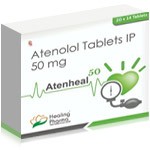Irregular Heartbeats: Understanding, Risks, and Treatment


The heart is one of the most remarkable organs in the human body, beating steadily day and night to supply oxygen-rich blood to every cell. Normally, it follows a precise rhythm that keeps life moving without interruption. However, there are times when this rhythm becomes disturbed. These disturbances are known as irregular heartbeats or arrhythmias. While the experience may be as harmless as a brief flutter in the chest or as severe as a life-threatening disruption in circulation, irregular heartbeats always deserve careful attention. This article explores what arrhythmias are, why they occur, their potential seriousness, ways to correct them, how people can live with them, and the role of medications like Atenheal in treatment.
What Is an Irregular Heartbeat?
An irregular heartbeat, medically referred to as arrhythmia, occurs when the electrical signals that control the heart’s contractions become disorganized or misdirected. The normal rhythm, called sinus rhythm, keeps the heart beating in a steady sequence. If those signals fire too fast, too slowly, or in a disordered manner, the heart rate changes unpredictably. Some arrhythmias are momentary and hardly noticed, while others persist and may interfere with effective circulation.
Arrhythmias are broadly classified into categories based on their pattern: tachycardia when the heart beats too fast, bradycardia when it beats too slowly, and fibrillation when the heart quivers rather than contracting efficiently. Each type may carry different implications for health. For example, atrial fibrillation is one of the most common and can increase the risk of stroke, while ventricular arrhythmias can be life-threatening if untreated.
What Causes Irregular Heartbeats?
Understanding the cause of an irregular heartbeat requires looking at both the heart itself and the body as a whole. Electrical impulses in the heart can be disrupted by structural problems, chemical imbalances, or external influences. In some individuals, arrhythmias appear with no clear structural abnormality, while in others they result from longstanding cardiovascular disease.
Common causes include coronary artery disease, where narrowed vessels reduce blood flow to the heart muscle, and heart valve disorders that alter the heart’s workload. High blood pressure places chronic strain on the heart and increases the likelihood of electrical disturbances. Other contributors include thyroid disorders, sleep apnea, excess caffeine or alcohol, smoking, electrolyte imbalances, and certain medications. Stress and stimulants can also provoke irregular rhythms, even in otherwise healthy individuals.
Genetic predispositions play a role as well. Some people are born with abnormalities in the heart’s electrical conduction system that make them prone to arrhythmias. In others, age-related changes to heart tissue and conduction pathways create instability over time.
Is an Irregular Heartbeat Serious?
The seriousness of an irregular heartbeat depends largely on its type, frequency, and underlying cause. Some arrhythmias are benign and do not threaten health. For instance, occasional premature beats are common and often go unnoticed. They may feel like skipped beats or brief palpitations and usually do not require treatment.
However, other forms can be extremely serious. Atrial fibrillation increases the risk of stroke fivefold because blood pooling in the atria can form clots. Ventricular fibrillation, on the other hand, causes the heart to stop pumping blood effectively and is a medical emergency that can lead to sudden cardiac death within minutes if not corrected. Bradyarrhythmias that severely slow the heart may result in dizziness, fainting, or heart failure symptoms.
Because the distinction between harmless and dangerous arrhythmias is not always obvious to the patient, medical evaluation is crucial whenever irregular heartbeats are persistent, severe, or accompanied by chest pain, shortness of breath, or fainting.
How to Correct an Irregular Heartbeat?
Correction of arrhythmia involves both addressing the immediate rhythm disturbance and treating underlying causes. The method depends on the type and severity of the irregular heartbeat.
For some, lifestyle adjustments are sufficient. Reducing caffeine and alcohol, managing stress, maintaining a healthy weight, and treating conditions like hypertension or diabetes can significantly improve rhythm stability. Exercise, when done safely under medical supervision, strengthens the cardiovascular system and reduces arrhythmia triggers.
When arrhythmias require medical intervention, doctors may prescribe antiarrhythmic medications to restore or maintain normal rhythm. Beta-blockers, calcium channel blockers, and other drugs slow the heart rate and stabilize electrical activity. In certain urgent situations, cardioversion — delivering a controlled electric shock to the heart — may reset its rhythm. Catheter ablation procedures can eliminate small areas of tissue that misfire electrically, offering long-term relief.
For patients whose hearts beat too slowly, pacemakers are implanted to maintain an adequate rate. In those at risk of life-threatening arrhythmias, implantable cardioverter-defibrillators (ICDs) detect and correct dangerous rhythms automatically. Each of these treatments is chosen carefully based on patient condition and risk profile.
Can You Live Normally With Heart Arrhythmia?
Living with arrhythmia depends on its nature, severity, and response to treatment. Many individuals with mild or well-controlled arrhythmias lead completely normal lives. They may need regular checkups, take daily medications, or avoid certain triggers, but they can work, exercise, and enjoy family life much like anyone else.
For those with more complex arrhythmias, adjustments are often necessary. It may mean learning to monitor heart rate, taking blood thinners to reduce stroke risk, or carrying identification noting their condition. Some individuals need to modify exercise routines or manage fatigue associated with irregular rhythms. Yet with modern therapies and close medical supervision, quality of life can remain high.
Importantly, emotional adaptation plays a role. The awareness of an irregular heartbeat can provoke anxiety. Support from healthcare providers, education, and sometimes counseling helps patients maintain confidence and independence while minimizing worry about sudden events.
The Role of Atenheal in Treatment
Among the medications used to manage arrhythmia, Atenheal plays a valuable role. Atenheal is a brand of atenolol, a beta-blocker. Beta-blockers work by slowing the heart rate and reducing the heart’s workload. They block the effects of adrenaline, preventing sudden surges in heart rate and stabilizing the rhythm.
In arrhythmia care, Atenheal is particularly useful for conditions such as atrial fibrillation, supraventricular tachycardia, and certain forms of ventricular arrhythmia. By moderating the rate of electrical impulses, it prevents the heart from racing uncontrollably and allows chambers to fill and pump more efficiently. It also reduces the risk of arrhythmia triggered by stress or exertion.
Atenheal is not suitable for all patients, however. Those with very slow heart rates, severe asthma, or advanced heart failure may not tolerate it well. Doctors carefully evaluate each case before prescribing it, considering interactions with other drugs and overall cardiovascular health. When used appropriately, it can be a cornerstone in arrhythmia management, often combined with other treatments like anticoagulants or ablation procedures.
Patients prescribed Atenheal need to take it regularly as directed, since abrupt discontinuation can worsen arrhythmias or trigger rebound effects. Side effects may include fatigue, dizziness, or cold extremities, though many people tolerate it well. With careful monitoring, it improves both symptoms and long-term outcomes.
Balancing Treatment With Everyday Life
Managing arrhythmia involves more than just medication or procedures; it requires a comprehensive lifestyle approach. Patients are encouraged to maintain a heart-healthy diet rich in fruits, vegetables, whole grains, and lean proteins. Limiting salt helps control blood pressure, while avoiding excessive alcohol and caffeine prevents unnecessary stimulation of the heart.
Exercise is beneficial but must be balanced with safety. Light to moderate activity strengthens the cardiovascular system, but patients should discuss limits with their doctor. Stress management techniques such as yoga, meditation, or simple breathing exercises reduce adrenaline surges that may trigger arrhythmias.
Regular medical checkups are critical. Monitoring ensures that treatment is effective and allows early detection of changes in rhythm or complications. Patients often undergo periodic electrocardiograms or wear portable monitors to track heart activity.
Family and social support matter as well. Explaining the condition to loved ones helps them understand possible symptoms and provides reassurance in emergencies. With open communication, individuals feel less isolated and more empowered to live fully.
Looking Ahead
The outlook for people with arrhythmia has improved dramatically in recent decades. Advances in electrophysiology, the branch of cardiology that studies heart rhythms, have given doctors tools to identify and treat irregular heartbeats with precision. From sophisticated ablation procedures to wearable devices that track rhythms continuously, technology now offers patients both safety and peace of mind.
New medications continue to be developed, offering more targeted control with fewer side effects. Research into genetic causes may lead to personalized treatments in the future. At the same time, the simple measures of maintaining a healthy lifestyle, following medical advice, and staying informed remain powerful tools for living well with an irregular heartbeat.
Conclusion
Irregular heartbeats can range from harmless flutters to dangerous disruptions, but they always reflect the intricate balance of the heart’s electrical system. Their causes are diverse, from structural heart disease to lifestyle factors and genetics. Whether serious or mild, they demand attention to prevent complications. Correction may involve lifestyle change, medication like Atenheal, procedures, or implanted devices, all aimed at restoring or maintaining stable rhythm.
With appropriate care, many people live normal, fulfilling lives despite arrhythmia. Education, monitoring, and treatment transform a potentially frightening condition into one that can be managed effectively. The message is clear: while the rhythm may falter, life does not have to.
Drug Description Sources: U.S. National Library of Medicine, Drugs.com, WebMD, Mayo Clinic, RxList.
Reviewed and Referenced By:
Dr. Alan Carter, PharmD Clinical pharmacist with expertise in cardiovascular pharmacology and medication safety. Frequently cited on Drugs.com and the National Library of Medicine for reviewing therapeutic guidance on beta-blockers, including atenolol (Atenheal), and their role in arrhythmia management.
Dr. Carol DerSarkissian, MD Board-certified internist and long-standing medical contributor to WebMD. She provides clinical reviews on cardiovascular health, particularly arrhythmias such as atrial fibrillation and supraventricular tachycardia, ensuring accurate and patient-friendly medical content.
Dr. Dianne B. McKay, MD Professor of Clinical Pharmacology and contributor to NIH publications. Her work focuses on drug safety in chronic disease, including the renal implications of cardiovascular drugs and long-term monitoring of patients with arrhythmia on beta-blocker therapy.
Dr. William C. Shiel Jr., MD, FACP, FACR Chief Editor at MedicineNet and affiliated with WebMD. He has authored authoritative content on cardiology topics, covering the causes, diagnosis, and treatment of irregular heart rhythms as well as the pharmacological mechanisms of common antiarrhythmic drugs.
Dr. Steven Gans, MD Harvard-trained physician and medical reviewer for Verywell Health and WebMD. He highlights the psychological impact of chronic cardiovascular conditions, including arrhythmia, and emphasizes holistic care that addresses both physical and emotional well-being in patients.
(Updated at Sep 25 / 2025)

